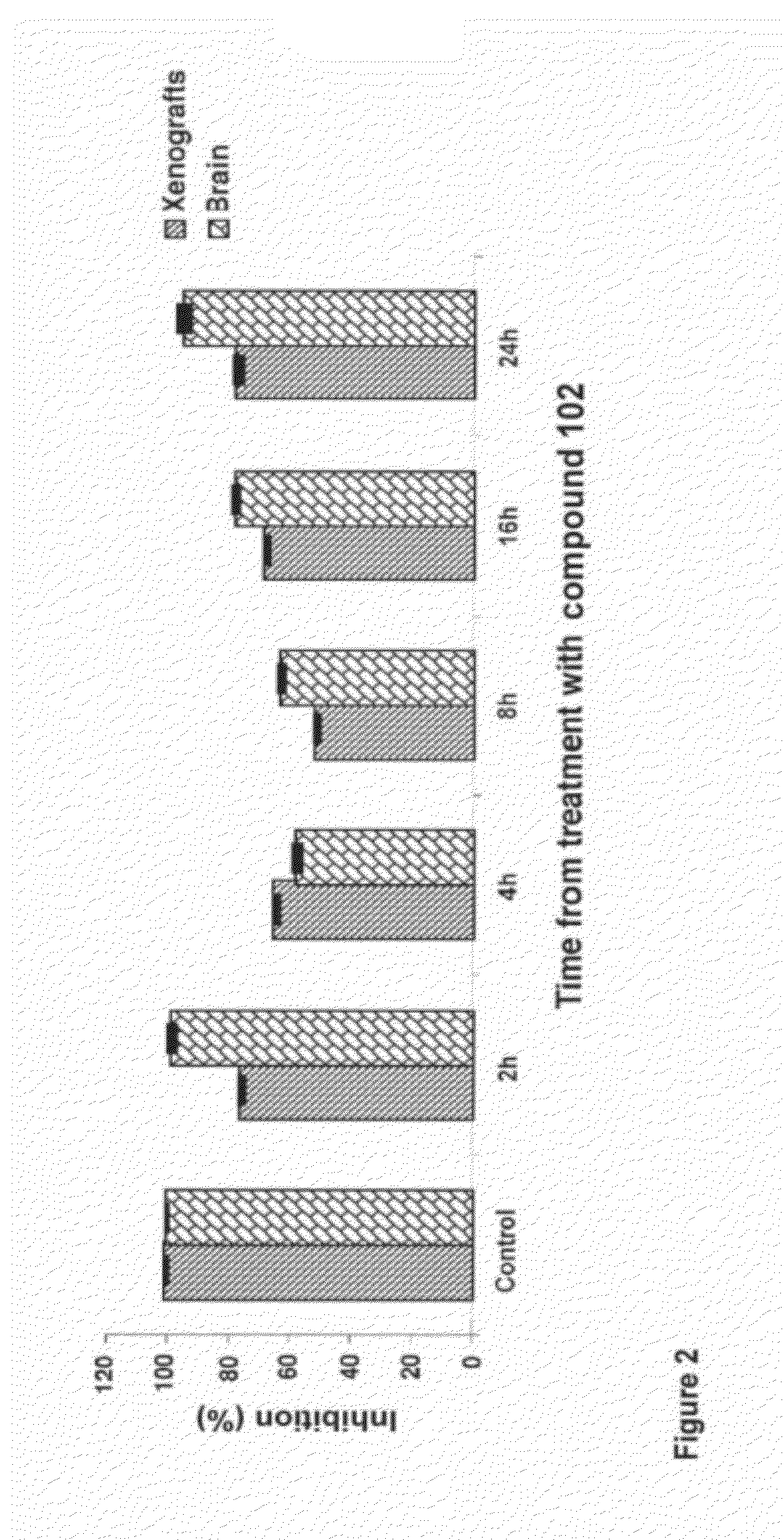Methods of modulating cell regulation by inhibiting p53
a cell regulation and p53 technology, applied in the field of p53 modulation, can solve the problems of fewer than 1 percent of adult cells being successfully re-programmed, inefficiency of the conversion process, etc., and achieve the effects of increasing the likelihood of producing an ips, and increasing the production efficiency of ips
- Summary
- Abstract
- Description
- Claims
- Application Information
AI Technical Summary
Benefits of technology
Problems solved by technology
Method used
Image
Examples
example 1
Inhibition of PP2A Diminishes a Major Defense Against DNA Damage, Cell-Cycle Arrest by p53 by Reducing the Cell Concentration of p53
[0189]Compound 102 inhibits PP2A and PP1 in lysates of human glioblastoma cell line U87 (FIG. 1) and inhibits PP2A in vivo in xenografts of U87 (subcutaneous) and in normal brain tissue of SCID mice (FIG. 2). Exposure of U87MG cells in culture to compound 102 resulted in increased phosphorylated Akt (pAkt-1), Plk-1 (pPlk-1), and a marked decrease in translationally controlled tumor protein (TCTP; FIG. 3). TCTP is an abundant, highly conserved, multifunctional protein that binds to and stabilizes microtubules before and after mitosis and also exerts potent anti-apoptotic activity (Bommer and Thiele, 2004; Yarm, 2002; Susini et al, 2008). Decreasing TCTP with anti-sense TCTP has been shown by others to enhance tumor reversion of v-src-transformed NIH 3T3 cells and reduction of TCTP is suggested to be the mechanism by which high concentrations of certain a...
example 2
Effects of Compound 102 on Decreasing p53 are Maintained in the Face of DNA Damage by the DNA-Damaging Agent, Temozolomide (TMZ)
[0191]We found that there is an increase in tumor cell killing by compound 102 plus TMZ because inhibition of PP2A renders cells more vulnerable to TMZ by inhibiting p53 mediated DNA damage arrest (Lu et al., 2009). The effects of compound 102, TMZ, and compound 102 plus TMZ on the amount of pAkt, p53 and MDM2 in U87MG, a cell line with wild-type p53 (Short et al, 2007) were assessed by Western blots. Exposure of U87MG cells to compound 102 alone for 24 hours increased both pAkt-1 and MDM2 and eliminated p53; TMZ alone decreased pAkt-1, increased p53, and had little effect on MDM2. Adding compound 102 prevented the decrease in pAkt-1 caused by TMZ alone and increased MDM2 in the face of continued increased expression of p53 (FIG. 5).
example 3
Effects of PP2A Inhibition by Compound 102 on p53 are Mimicked by Another Known Inhibitor of PP2A, Okadaic Acid
[0192]The same molecular changes in pAkt-1 and p53 induced by compound 102, TMZ, and compound 102 plus TMZ occurred in U87 cells when Okadaic acid, at a concentration (2 nM) that is expected to inhibit PP2A and not PP1 (Hart et al, 2004), was substituted for compound 102 (FIG. 6) supporting the hypothesis that the effects of compound 102 result from inhibition of PP2A.
PUM
 Login to View More
Login to View More Abstract
Description
Claims
Application Information
 Login to View More
Login to View More - R&D
- Intellectual Property
- Life Sciences
- Materials
- Tech Scout
- Unparalleled Data Quality
- Higher Quality Content
- 60% Fewer Hallucinations
Browse by: Latest US Patents, China's latest patents, Technical Efficacy Thesaurus, Application Domain, Technology Topic, Popular Technical Reports.
© 2025 PatSnap. All rights reserved.Legal|Privacy policy|Modern Slavery Act Transparency Statement|Sitemap|About US| Contact US: help@patsnap.com



